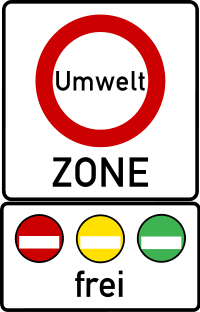Low-emission zone
A low-emission zone (LEZ) is a defined area where access by some polluting vehicles is restricted or deterred with the aim of improving the air quality. This may favour vehicles such as (certain) alternative fuel vehicles, hybrid electric vehicles, plug-in hybrids, and zero-emission vehicles such as all-electric vehicles.

A zero-emission zone (ZEZ) is a LEZ where only zero-emission vehicles (ZEVs) are allowed. In such areas, all internal combustion engine vehicles are banned; this includes any plug-in hybrid vehicles which cannot run zero-emission.[1] Only battery electric vehicles and hydrogen fuel cell vehicles are allowed in a ZEZ, along with walking and cycling and fully electric public transport vehicles, e.g. trams, electric buses etc.
Europe

As of 2019 there are about 250 low-emission zones (LEZ),[2] which help meet EU health-based air quality limit values. This means that vehicles may be banned from a LEZ, or in some cases charged if they enter a LEZ when their emissions are over a set level.
Different vehicles may be regulated, depending on local conditions. All LEZs apply to heavy vehicles, some to diesel vans, others also to diesel and petrol cars; in Italy, motor cycles and three-wheelers are also liable to control.
A publicly funded website run by a network of cities and ministries operating or preparing LEZs gives up-to-date information on LEZs, such as which cities have LEZs, the vehicle types affected, the required emissions standards and their application dates.[3]
Belgium
- Antwerp: Since 2017, there has been a LEZ in Antwerp, 24/7. Only diesel vehicles above Euro 3/III norm and petrol vehicles above Euro 1/I norm are allowed to enter the LEZ.[4]
- Brussels: Since 2018, the entire Brussels Capital Region has been a LEZ.[5] Only diesel vehicles above Euro 2/II norm are allowed to enter Brussels.
Since 2019 petrol or gas-powered vehicles need to be Euro 2/II or more.[6] - Ghent introduced a LEZ on 1 January 2020.[7]
Denmark
Denmark has LEZ's that are applicable to vehicles over 3.5T.[3] In Denmark, LEZ's exist in Aalborg, Århus, Copenhagen, Frederiksberg and Odense.[8]
Finland
An LEZ is present in Helsinki.[9]
France
France has LEZ's in Greater Paris, Grenoble, Lyon, Paris and Strasbourg[10]
Germany
In Germany, an LEZ is called an environmental zone (Umweltzone). There are currently 47 LEZs in operation or in planning in Germany.[3] The cities of Berlin, Cologne, Hanover Mannheim and Stuttgart started LEZs in their respective central city areas in 2008 and more cities followed in the years after.
Italy
Italy has LEZ's that are applicable to all vehicles.[3] There are combined LEZ's and urban road tolling schemes in Milan and Palermo as well as low emission zones with differing standards and timeperiods. The latter are mainly found in north Italy, but also in mid Italy and Sicily.[11]
Netherlands
Rotterdam and Utrecht have LEZs. In Rotterdam this applies to trucks with a diesel engine that fall under stages Euro-I, Euro-II and Euro-III of the EU emission standards; delivery vans and passenger cars with a diesel engine registered before 2001; and delivery vans and passenger cars running on petrol/LPG registered before July 1992[12]. In Utrecht this applies only to diesel vehicles registered before 2001.
Norway
Norway has LEZ's in Bergen and Oslo.[13]
Portugal
Portugal has an LEZ in Lisbon.[14]
Spain
Spain has LEZ's in Barcelona and Madrid.[15]
Sweden
The cities of Gothenburg, Lund, Malmö, Helsingborg, Mölndal, Uppsala, Umeå and Stockholm have low-emission zones.[16] Heavy trucks and buses with compression ignited engines (mainly diesel engines) may not be allowed inside the environmental zones depending on their age and on their emission class.[17]
United Kingdom
.jpg)
The London low emission zone came into effect in 2008 covering almost all of Greater London - the largest such zone in the world. London currently has levels of air pollution among the worst in Europe and road transport related emissions account for around half of total emissions of PM10 and NOx in the capital. The Low Emission Zone targets emissions of these pollutants from older diesel-engined lorries, buses, coaches, vans, minibuses and other heavy vehicles that are derived from lorries and vans such as motor caravans and motorised horse boxes. There was a phased introduction of the scheme from 2008 through to 2012. Different vehicles were affected over time and increasingly tougher emissions standards applied.[18]
The London Ultra Low Emission Zone started on 8 April 2019. In the context of the coronavirus pandemic, Mayor Sadiq Khan asked TfL to suspend enforcement of the next phase of LEZ standards which had been due to come into force on 26 October, so that these would apply instead from the end of February 2021.[19]

Glasgow introduced a Low Emission Zone (LEZ) at the end of 2018. Initially, only local buses in the centre of the city are affected. The city council plans to extend restrictions to all vehicles, including older petrol and diesel cars, from December 2022.[20] Norwich, Leeds, and York also introduced a LEZ.[21][20]
Since 2015, more than 60 local authorities have been ordered to tackle illegal levels of air pollution, which is why many of these planning to introduce clean air zones. The following cities have plans to introduce LEZs: Aberdeen (2020), Bath (2021), Birmingham (2019), Derby, Dundee (2020), Edinburgh (2020), Manchester (2021), Newcastle (2021), and Sheffield (2021).[20]
As of June 2020, Oxford is slated to become the first city to implement a Zero Emission Zone (ZEZ) scheme, beginning with a small area to go into effect by mid 2021. It was postponed from a 2020 start due to the economic impacts of the COVID-19 pandemic. The plan is to expand the ZEZ gradually into a much larger zone, until the ZEZ encompasses the majority of the city centre by 2035.[22][20][23]
Elsewhere
Japan
In Tokyo, the municipal government decided to tackle controlling diesel vehicle emissions (particulate matter emissions, ...) far ahead of the national government.[24][25]
Hong Kong
Since the end of 2015, the Hong Kong Government has designated three major junctions in Central, Causeway Bay and Mong Kok as low emission zone for franchised buses. For bus routes entering the three zones, franchised bus operators are required to use only buses meeting emission standards of Euro IV or above except when necessary. The LEZ scheme does not cover vehicles other than franchised buses.[28] As of December 31, 2019, the standard for entry into the LEZ has been increased to Euro V.
Workings
In many LEZ's, vehicles that do not meet the emission standards set by the LEZ are not barred from entry into the LEZ (i.e. using automated boom barriers), but rather simply fined if they enter the zone. A fine is not issued if entering the LEZ with a vehicle that does not meet the emission standards, when a fee (LEZ daily charge, ...) has been paid. In some LEZ's, such as the one in London, this is done by ANPR cameras which read the vehicle registration number plate as they enter the LEZ and then compare it against a database of vehicles which:
- either meet the LEZ emissions standards,
- or are either exempt or registered for a 100 per cent discount,
- or if the LEZ daily charge has been paid[29]
This fee/fine works as a deterrent for those having a vehicle that does not meet the LEZ emission standard for entering the city, and those having such vehicles will hence try to avoid paying this fee/fine (using various means, see "intent and actual impact").
Intent and actual impact
The intent of LEZ's is generally to improve air quality within cities.[30] This intent is indeed achieved, with diesel particulates (PM10) dropping in most LEZ's.[31]
Often, this is achieved as people with polluting vehicles replace them with vehicles that attain a higher emission standard,[32] which may mean buying a new vehicle. Some people (such as workers on night shift or carrying heavy tools or cargo) however can't do without a car, but might not be able to afford to purchase unsubsidized cleaner vehicles. Therefore in some places the LEZ is only enforced when public transport is available, or electric taxis[33] or cargobikes are subsidized.[34]
Transport & Environment is of the opinion that LEZ's should be gradually turned into zero-emission mobility zones and complement policies promoting a switch to clean alternatives, including walking and cycling, amongst others.[35]
Most LEZ's which are not also congestion charge zones do not change the number of vehicles entering the zone: but some LEZ's (such as the one in Milan) double as congestion charge zones and thus have the potential to reduce the numbers travelling into the city.[36]
See also
- Automatic number-plate recognition
- Battery electric vehicle
- Crit'air
- Carfree city
- Congestion pricing
- Ecopass
- Electric car
- Electric car LCA
- Green number plates
- List of modern production plug-in electric vehicles
- Phase-out of fossil fuel vehicles
- Plug-in electric vehicle
- Plug-in hybrid
- Road space rationing
- Sustainable transport
- Transit mall
- Zero-emissions vehicle
References
- Council, Oxford City. "Oxford Zero Emission Zone (ZEZ) frequently asked questions". www.oxford.gov.uk. Retrieved 2020-01-06.
- McGrath, Matt (2019-04-08). "London's ULEZ: How does it compare?". Retrieved 2019-06-19.
- "Urban Access Regulations in Europe". Sadler Consultants Ltd. Retrieved 2019-06-19.
- "Antwerp LEZ". Stad Antwerpen. Retrieved 2017-03-08.
- "La LEZ (Brussels LEZ-map)". Brussels Capital Region. Retrieved 2017-03-08.
- "Mon Véhicule (Table of allowed Vehicles)". Brussels Capital Region. Retrieved 2017-03-08.
- "Lage-Emissiezone 2020". Stad Gent. Retrieved 2017-11-11.
- LEZ's Denmark
- LEZ's Finland
- LEZ's in France
- LEZ's Italy
- http://www.gezonderelucht.nl/healthier-air-rotterdam
- LEZ's in Norway
- LEZ's in Portugal
- LEZ's in Spain
- "Urban Access Regulation in Europe". Retrieved 21 December 2016.
- "Miljözoner". Retrieved 12 January 2017.
- "Emissions standards". Transport for London. Retrieved 2007-11-21.
- Matters, Transport for London | Every Journey. "Transport for London to temporarily postpone enforcement of new stricter rules for freight vehicles on the capital's roads". Transport for London. Retrieved 2020-04-27.
- Tobin, Dominic (2019-03-12). "Clean air zone charges: where are Britain's low emission zones?". buyacar.co.uk. Retrieved 2020-03-29.
- [Norwich Low Emission Zone https://laqm.defra.gov.uk/documents/Norwich_lez.pdf]
- Oxford City Council (2020-03-20). "Oxford's Zero Emission Zone - 20/03/2020 update". Oxford City Council. Retrieved 2020-06-18.
- https://www.oxford.gov.uk/info/20216/air_quality_management/208/oxfords_low_emission_zone_lez
- Tokyo Metropolitan Government's Efforts to Control Diesel Vehicle Emissions
- TMG: Measures against Diesel Emissions
- Beijing Low Emission Zone
- LEZ examples
- Government sets up franchised bus low emission zones starting today Archived February 2, 2016, at the Wayback Machine
- [https://www.ifsecglobal.com/uncategorized/anpr-cameras-used-for-london-emission-zone/ ANPR cameras used for London emission zone
- Views sought on ‘inner London’ ULEZ
- Impact of Low Emission Zones
- Five years of London’s low emission zone: Effects on vehicle fleet composition and air quality
- "Subsidies on offer to taxi drivers who switch to electric vehicles". Bristol City Council News. Retrieved 2020-01-06.
- Reid, Carlton. "London Wants Vans Replaced By Cargobikes, Introduces Subsidy And Behavior Change Program". Forbes. Retrieved 2020-01-06.
- Our city needs fewer cars, not cleaner cars
- Impact of Low Emission Zones